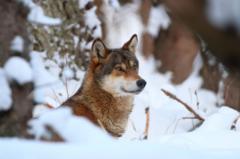As the winter season begins and snow blankets the picturesque village of Sansimion in Romania's eastern Carpathians, the longstanding debate surrounding wolf protection has intensified. Shepherd József Rácz, whose family tends to a flock of 500 sheep, faces the daily challenge of safeguarding his herd from wolves and bears—a struggle that has become even more complex with the possible deregulation of wolf protections in Europe.
This week, the European Commission may finalize a proposal to transition wolves from Annex II (strictly protected) to Annex III (protected) of the Bern Convention. If successful, this shift would enable EU member states to establish their quotas for wolf culls, effectively signaling an end to 45 years of stringent protections.
Currently, the population of wolves in Europe has risen dramatically, nearly doubling from approximately 11,000 in 2012 to over 20,000 today. While the Commission justifies the need for action due to perceived livestock threats, advocates for wolf conservation argue that implementing better protective measures—such as the use of trained sheepdogs—might be a more effective solution. They emphasize the ecological role of wolves in managing deer and wild boar populations, which not only protects trees and crops but also aids in disease control.
Recent discussions among wildlife experts in nearby Baile Tusnad revealed a widespread opposition to the hunting of wolves and bears. Biologist Michal Haring highlighted the role of wolves in mitigating diseases like African swine fever, pointing out that these predators can suppress illnesses without being affected themselves.
Despite the stark realities faced by shepherds like József, proponents of wolf conservation cite a 2023 EU report indicating that only about 50,000 out of 68 million sheep and goats are killed by wolves each year. This statistic suggests that the impact of wolves on livestock is minimal, particularly given that no fatal wolf attacks on humans have occurred in recent decades.
Protecting wolves may also be a moral obligation for wealthier nations. Laurent Schley, head of the Wildlife Department in Luxembourg, emphasizes the need to extend conservation values to wolves in Europe, just as there is a worldwide expectation to protect species like tigers and elephants.
Back in the mountains, however, Rácz worries about the increasing wolf population, expressing a need for more robust measures to protect his livestock. Last year, he lost his beloved sheepdog to a wolf attack, an incident that solidified his belief that wolves pose a significant risk to his livelihood. "The more wolves there are, the more likely they will take my sheep," he asserts, highlighting the delicate balance between wildlife conservation and agricultural practices in Europe.














